C4.6 - Genetic Research
Genomes
Dissecting Genomes
- genome: full DNA sequence of an organism
- 1st draft of the human genome was completed in June 2000
- results were published in Nature and Science
- the DNA sequenced came from multiple individuals
- only 1.5–2% of the genome contains actual genes
- other 98% includes repeats, regulatory regions, and viral DNA
Manipulating DNA
- most DNA molecules very long
- must be cut into smaller pieces before analysis
- “molecular scissors” to cut DNA: bacteria
- restriction enzymes: bacterial proteins that cut DNA wherever a particular nucleotide sequence occurs
- restriction fragments: pieces of DNA cut out using restriction enzymes
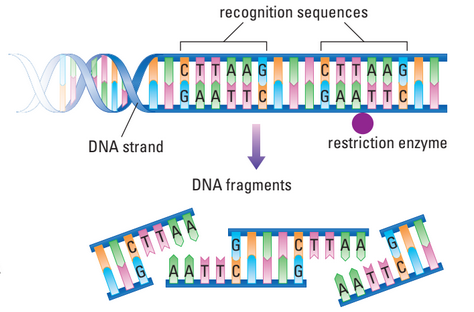
Gel Electrophoresis
- once DNA cut, pieces sorted and analyzed using gel electrophoresis
- DNA gel (looks like gelatin slab) porous
- DNA fragments added to one end of gel
- electric current applied
- DNA negatively charged → move towards positive end
- smaller fragments move faster
- produces a band when done
- “DNA fingeprint”
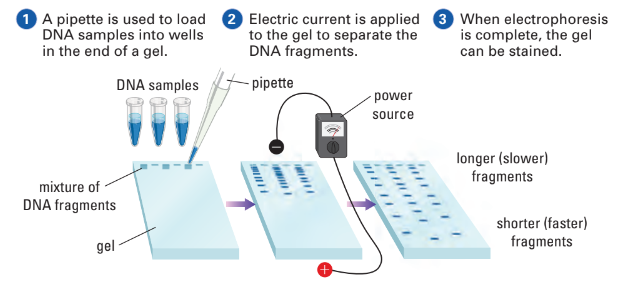
DNA Sequencing
- DNA sequencing: determining the order of nucleotides in DNA
- completing the human genome required hundreds of automated machines
- machines use robotics to handle DNA
- computer programs analyze sequencing data
- newer technologies are faster and more efficient
- nucleotides are labeled with fluorescent dyes
- DNA strands are separated and one is used as a template
- complementary strand is built one nucleotide at a time
- a flash of light signals which nucleotide is added
- system records the sequence based on the light
Bioinformatics
- bioinformatics: science of handling and analyzing biological data
- involves creation, devel., and operation of
- databases
- and other computational tools
- to collect, organize, and interpret data
- i.e. nucleotide sequences stored in searchable DBs
- researches then use programs to recognize and align overlapping nucleotide sequences
- DNA sequences from Human Genome Project housed in GenBank (public access)
Some Completed Genomes
| Species | Genome Size (Base Pairs) | Approximate Number of Genes |
|---|---|---|
| Haemophilus influenzae (bacterium) | 1.8 million | 1,700 |
| Escherichia coli (bacterium) | 4.6 million | 4,400 |
| Saccharomyces cerevisiae (yeast) | 12 million | 6,200 |
| Caenorhabditis elegans (nematode) | 96 million | 19,000 |
| Arabidopsis thaliana (mustard plant) | 125 million | 25,500 |
| Drosophila melanogaster (fruit fly) | 170 million | 13,700 |
| Oryza sativa (rice plant) | 470 million | 60,000 |
| Mus musculus (mouse) | 2.6 billion | 30,000 |
| Rattus norvegicus (lab rat) | 2.8 billion | 25,000 |
| Macaca mulatta (macaque) | 2.9 billion | 22,000 |
| Pan troglodytes (chimpanzee) | 3.1 billion | 22,000 |
| Homo sapiens (human) | 3.2 billion | 21,000 |
Genomics
- genomics: study of genomes
- goal of genomics: map location of genes within genome
- key identifier regions used to map genes; incl.
- switches that turn genes on or off
- start codons at beginning of genes
- stop codons at end of genes
- key identifier regions used to map genes; incl.
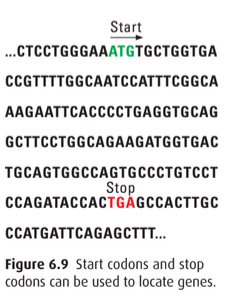
- coding regions of genes contain instructions for making proteins
- i.e. alpha globulin gene has a coding region for hemoglobin
- noncoding regions help locate genes but their roles are not fully known
- gene mapping helps identify disease-related genes
- i.e. Parkinson’s disease which affects brain cell function
- symptoms include tremors, speech problems, and muscle rigidity
- before the Human Genome Project, genetic links to Parkinson’s were unclear
- researchers compared DNA of people with and without Parkinson’s
- a mutation in a specific gene was found in many affected individuals
- this gene is also linked to Alzheimer’s disease
- other gene mutations connected to Parkinson’s have been found
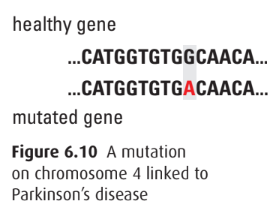
Model Organisms
- cross-species comparisons help reveal gene functions
- similar gene sequences in different species suggest similar roles
- human genes can be studied by comparing them to known mouse genes
- genes related to smell in rats and song-learning in birds are similar to a human gene linked to Parkinson’s
- studying these animals gives clues about gene function in humans
- this knowledge supports the development of treatments and cures
- functional genomics focuses on understanding gene functions
- researchers use model organisms like mice to study gene inheritance
- common model organisms include E. coli, C. elegans, yeast, fruit flies, and mice
- mice are especially useful because their development and genetics are well understood
- mice and humans have similar genome sizes and gene counts
- most human genes have a matching gene in mice
Applying Genomics
- DNA chip: small glass wafer or slide spotted with an array of single-stranded DNA fragments
- some spots, i.e. could contain DNA w/ cystic fibrosis causing mutations
- DNA chip process
- person provides DNA sample
- sample cut into pieces
- pieces tagged w/ fluorescent dye to make series of probes
- wherever there is match between probe and spot of DNA on chip, probe will bind
- fluorescent tag marks spot
- Uses
- DNA chips can be made to span large regions of human genome
- personalized health care
- i.e. sequencing rice genome to make rice more nutritious
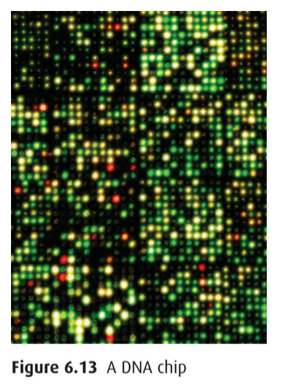
Genetic Engineering
Biotechnology
- biotechnology: use of organisms to make useful products
- i.e. prod. of vaccines, antibiotics, hormones, food products, enzymes in detergents
- genetic engineering: intentional production of new genes and alternation of genomes by sub. / intro. of new genetic material
- i.e. altering E. coli to make blue dye for jeans
Genetic Recombination
- 1940s: American scientists Joshua Lederberg and Edward Tatum demonstrated that 2 bacterial cells form a direct connection
- transfer of DNA
- viruses can also carry bacterial genes from one bacteria to another
- recombinant DNA technology: combination of genes from diff. sources into single DNA molecule
Making Recombinant DNA
- plasmid: small circular DNA molecule separate from larger bacterial chromosome
- bacteria share plasmids
- Steps for Making
- plasmid removed from bacterial cell
- desired gene inserted into plasmid
- recombinant plasmid: modified plasmid w/ desired gene inserted
- recombinant plasmid put back into bacterial cell
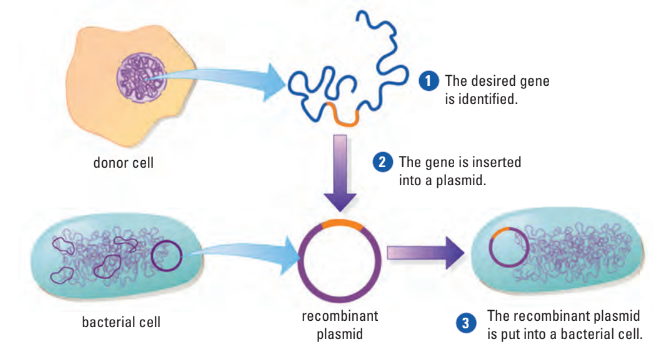
“Cutting and Pasting” DNA
- making a recombinant plasmid involves cutting and pasting DNA
- desired gene is cut from a longer DNA strand using restriction enzymes
- restriction enzymes make staggered cuts creating sticky ends
- sticky ends are single-stranded and can bind to complementary sequences
- sticky ends help join plasmid DNA with other DNA fragments
- DNA ligase pastes the sticky ends together to form a complete molecule
- Cloning Recombinant DNA
- gene cloning: process of putting recombinant plasmid into bacterial cell to make copies of particular gene
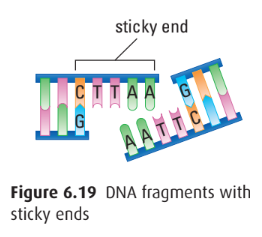
Applications
Genetically Modified Organisms (GMOs)
- genetically modified organism: organism w/ genetic material that has been altered through genetic engineering
- transgenic: acquired genes from different type of organism
- i.e. GMO bacteria Caulobacter crescentus w/ surface molecules that bind heavy metals
- remove heavy metals from drinking water
Producing Genetically Modified Plants
- recombinant DNA used to improve crop traits
- GM plants can have delayed ripening, better nutrition, stress tolerance, or disease resistance
- genetic engineering often replaces traditional breeding
- most useful when traits are controlled by few genes
- new plants can be grown from a single adult plant cell
- engineered cells can grow into full plants with new traits
- Agrobacterium plasmids used to insert genes into plant cells
- transgenic plants include tomato, potato, tobacco, soybean, walnut, apple
- DNA gun can insert genes into plants like corn
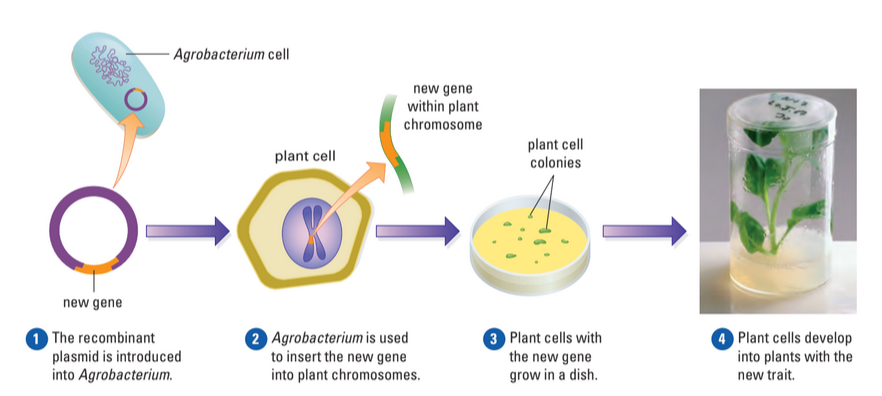
Pest-Resistant Crops
- i.e. incorporation of genes for bacterial toxin produced by Bacillus thuringiensis
- BT kills specific insects like corn borers and cotton bollworms
- w/o harming humans or most other animals
- upon ingestion, insect’s enzymes convert toxin into smth. that kills it
- other useful traits
- tolerance to herbicides (weed killers)
- resistance to viral infections
Plants as Factories
- GM plants used for making
- pharmaceuticals
- industrial products
- biofuels
- i.e. GM safflowers (Charthamus tinctorius)
- produces wide variety of products
- like easily purifiable insulin
- insulin extracted from oily seeds of plant
Producing Genetically Modified Animals
- more difficult than GM plants
- in vitro fertilization: fertilizing an egg in a test tube or laboratory dish, then transferring embryo to uterus (womb)
- many attempts needed before fertilized egg incorporates DNA from another source
Farm Animals and “Pharming”
- some goals: better-quality wool, leaner meat, fast-growing fish
- “pharming”: producing pharmaceuticals from transgenic animals
- most cases: add gene for desired human protein to genome of farm mammal
- added in such a way so that desired protein secreted via milk
- good method when human gene not expressed well in bacteria
Animal Cloning
- entire genomes can be cloned, not just individual genes
- first cloned mammal was Dolly the sheep in 1996
- since then, many mammals have been cloned including goats, cows, pigs, and cats
- animal cloning uses nuclear transplantation
- donor nucleus replaces nucleus of an unfertilized egg
- egg develops into a clone with the same genome as the donor
- cloning from somatic cells has low success and health risks
- cloning can mass-produce animals with desired traits
- faster than traditional breeding
- useful for preserving traits in GM animals without further genetic changes
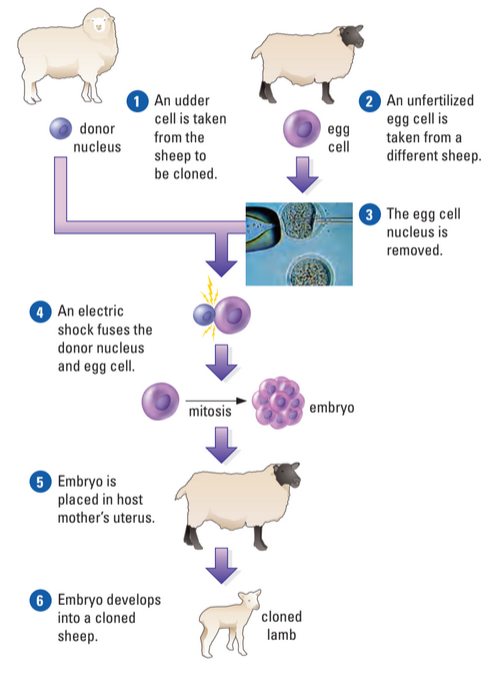
Process of cloning a sheep
Regulating Use of GMOs
- concerns exist about safety of GM crops and animals
- GM salmon might escape and compete with wild salmon
- GM crops could transfer genes to wild plants
- herbicide resistance could create hard-to-control super weeds
- GM plants sometimes found in non-GM fields
- pest-resistant GM crops not shown to pose major health or environmental risks
- strict regulations recommended for growing and using GM crops
- potential unknown risks to human health from GM products
- some consumers want clear labelling of GM foods
- pharmaceuticals from transgenic animals may differ from natural proteins
- GM proteins used in food or medicine must be tested for safety
- testing ensures GMOs don’t cause allergic or harmful reactions
Regulatory Agencies
- governments worldwide working to ensure biotech safety
- Canadian Food Inspection Agency (CFIA) regulates environmental release of novel plants in Ca.
- CFIA and Health Canada assess safety of biotech agricultural products
- includes food for people and feed for livestock
- product developers must follow regulations and guidelines
- detailed product information must be submitted for evaluation
Genetic Technology in Medical Research
- model organisms used to study gene function and develop therapies
- genes can be added or deleted at specific genome locations
- knockout mice have a gene intentionally disabled
- knockout technique helps identify gene functions
- altered mice are bred to create lines with specific traits
- knockout mice used to study obesity by targeting the ob gene
- mice with mutated ob gene overeat and become obese
- ob gene codes for leptin, a protein that signals fullness to the brain
- leptin affects fat and glucose metabolism
- research on leptin supports development of treatments for obesity disorders
- knockout mice also help study inherited diseases
- used to test new drugs and therapies
Gene Therapy
- one form of treatment for one suffering from disease caused by missing / malfunctioning gene
- gene therapy: process of supplementing or replacing gene in order to treat medical condition
- gene therapy involves delivering functional genes to affected cells
- i.e. viruses can be engineered to carry therapeutic genes
- modified viruses insert the gene into the patient’s DNA
- other delivery methods include transplants, injections, and inhalers
- gene therapy being studied for diseases like Huntington’s, skin cancer, and cystic fibrosis
- therapies are experimental and high-risk
- challenges include targeting the right cells and ensuring long-term effectiveness
- researchers aim to make delivery methods safe and reliable
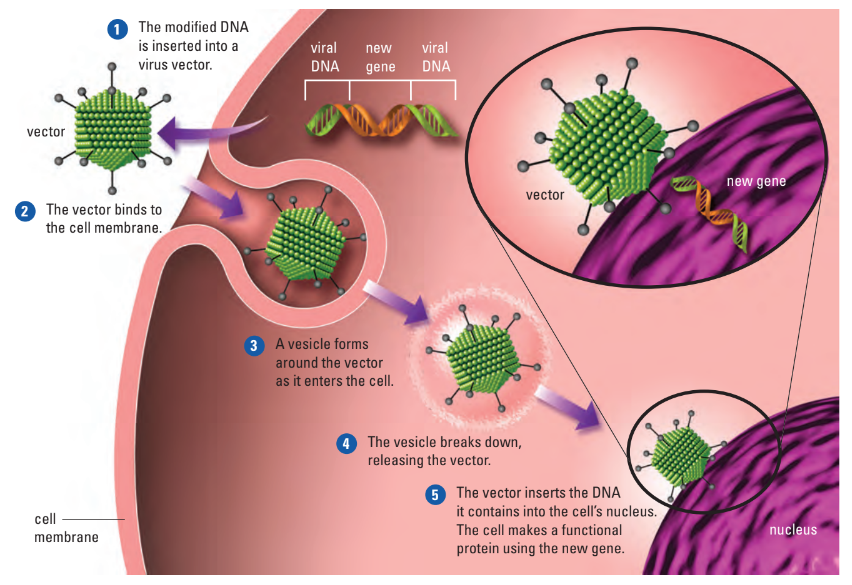
Process of gene therapy using a virus